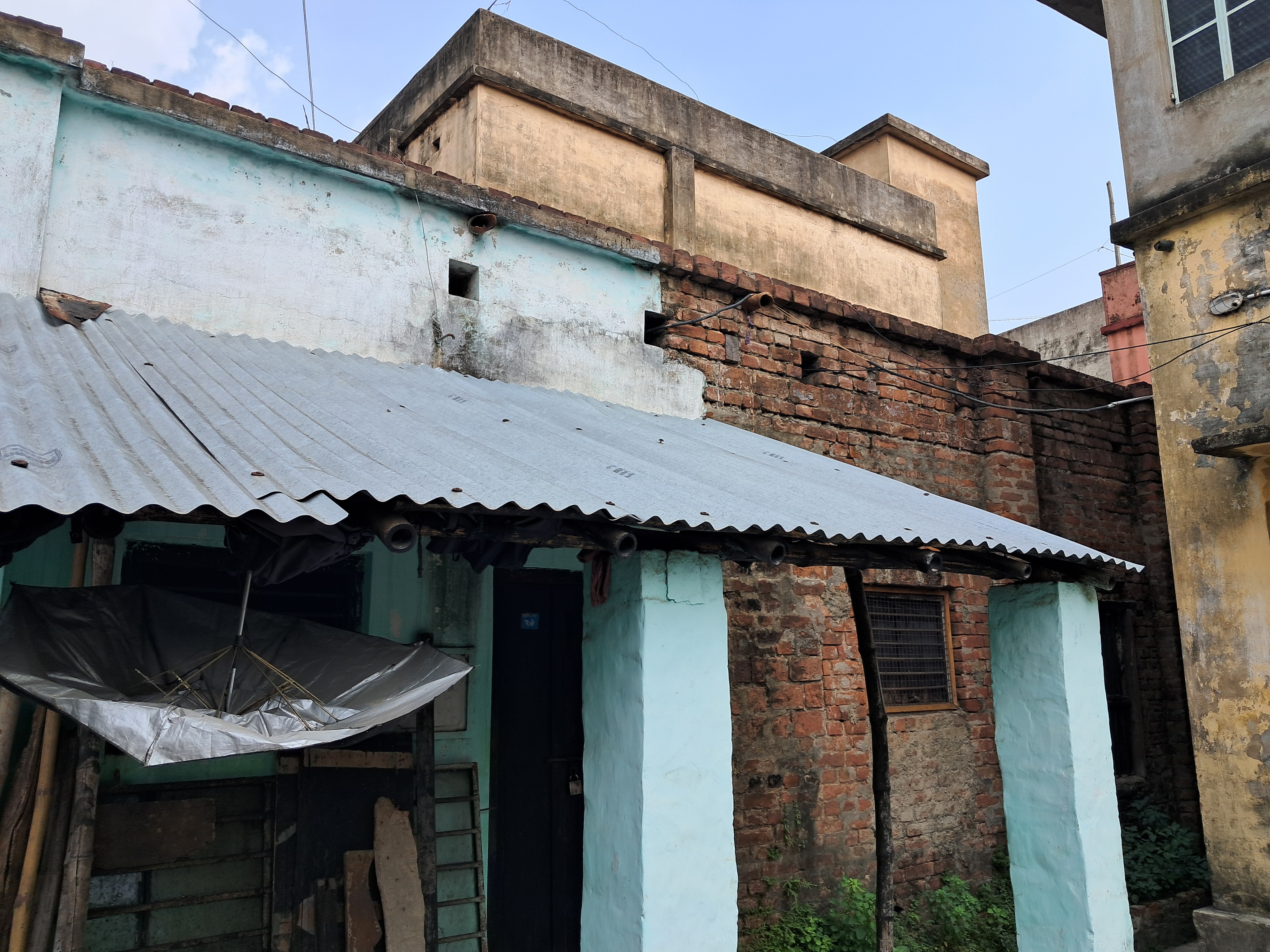The second attempt is perhaps one of the most natural ways to read negation. It is based on the historical contributions of Dharmakīrti and Dharmottara1. Cognition A consists of a negation. The Dharmakīrtians draw a distinction between two kinds of negation: implicative and non-implicative. This distinction is not special to them, for the Mīmāṃsakas and the Madhyāmika also hold it, although for other reasons.
Suppose I say, ‘The floor is not blue’. The idea is that I am implicitly saying that the floor is some other colour. This seems fairly natural. Here comes the genius reversal. Cognition A is read as the consequence of an alternative cognition, i.e., when I look at the locus, Nabadwip, I perceive something other than Nyāya, perhaps the neverending, dynamic crowd of Vaiṣṇava pilgrims moving towards Mayapur or the furniture shops, restaurants, totos and apartments. This perception is contrary2 to the perception of Nyāya manuscripts or learning institutions. This perception stands as a part of an implicative procedure that leads to the awareness of the non-perception of the counterpositive. The conclusion of this inference is the thesis that counterpositive is absent in the locus.
Very well. This may be the psychological explanation of the origin of the cognition A. Regardless of the veridicality of this explanation, one must also present a phenomenological description of the cognition A. I believe this is the source of dispute between the Bhaṭṭa, Prabhākara, Dharmakīrtian and Nyāya philosophers on absence. Both Kumārila and Gaṅgeśa take the phenomenological clarity of cognition of absence seriously. Prabhākara is interested in giving a description by presenting a phenomenological description as cognition of the bare locus yet showing the judgement as a consequence of a further psychological process. The Dharmakīrtian here presents an interesting position, giving preference to the psychological process yet maintaining the phenomenological description of objects here as no different for absences and presences. It is this very ambiguity that Zhihua Yao claims is a sign of the hesitation of this theory of negation between language and perception3.
Where does the negative come from in such a reading? Why do I not walk into Nabadwip and say, “There is no Māori philosophy in Nabadwip”? The answer here must come from outside the affirmative cognition itself. Husserl describes it as the disappointment of protentional anticipations of belief3, i.e., I expect to see Nyāya and not Māori philosophy here. My disappointment in failing to perceive the Nyāya is what results in my cognition taking the form of A. Of course, we need not remain in the domain of belief. As I am disposed to function in the world, I do not believe that my pen has ink. In particular, I do not believe anything; I only inhabit a particular propensity towards the world. I pick up my pen and attempt to write. The failure that confronts me is reflected as surprise. My experience, which eventually is crystallized as the judgement “There is no ink in the pen”, is one of failure of our habits and dispositions. One attempt, then, is to trace absences to failures of this sort.

Prasanna Tarkaratna’s ṭol now has a billboard for something else attached to it. Perhaps it is this that I saw and decided on the absence of Nyāya. Either way, I set out further to track down the location of Jānakīnātha Tarkacūḍāmaṇi’s ṭol. Siharan Chakraborty’s book A Brief History of Sanskrit Scholars of Nabadwip4 mentions that a dilapidated building existed at the time of writing the book. I was not particularly hopeful of finding it because the publication of the book and my trip had a solid gap of 25 years. A dilapidated house back then might as well have been replaced by something else today or merely been demolished entirely. In either case, it was going to be nigh impossible to find the actual location. The book mentions the name of the street, Nandipara Road, on which it stood. I set out to find it.
The validity of our cognition of absence then depends on a particular kind of failure: a failure to perceive or a failure of expectation. This is formalized in the epistemological description of Dharmakīrti when he claims that the anupalabdhi becomes evidence for the cognition of the form A. Nevertheless, we must ensure that we delineate between valid judgements and erroneous ones. Thus, we distinguish between objects of perception which are perceptible and imperceptible. Failures of perception of the former will be valid evidence for inference. I would need to spell out the details of how to cash out the word “Nyāya” in cognition A to show it is perceptible. I am neutral to this question, and it will be sufficient to merely equate it to material objects that are related historically or causally to Nyāya philosophy—buildings, books and the like. Now, what does this experience of failure consist of? Dharmakīrti prefers to say that this involves a perception of something contrary to the counterpositive. I run my pen on the page and see white tracks instead of black ink. I go to Nabadwip and see modern apartments, schools, and shops instead of ṭols.
After a good half an hour of slowly walking up and down the road, looking for any clues, I saw a jewellery shop on the street. My companion for the trip, the man who drove me all the way, was also heavily invested in finding this once I got to chatting with him over lunch about the trip. I did my best to explain whatever I was studying and looking for in the broken Hindi-Bengali mixture that we shared for the trip. Both of us entered the shop together to speak to the people sitting inside. Four men were hanging out inside, enjoying the AC and escaping the clammy heat. They took a second to recalibrate after my inquiry of directions to the Jānakīnātha Tarkacūḍāmaṇi’s ṭol. It seemed none of them had heard of the man or this particular ṭol or, at the very least, did not understand my question about them. The oldest man, however, chimed in after a minute or two of pestering from both my companion and me. He finally understood that we were looking for a chatuṣpāṭhi (the word they all seemed to recognize). He quickly spoke to another man, who in turn ushered us outside and walked with us a few feet. He showed us the location of a building, now rebuilt as an ordinary home. He told us that there used to be a chatuṣpāṭhi here and alleged that it was the only one on this road. Perhaps this was the location of Jānakīnātha Tarkacūḍāmaṇi’s ṭol. As I had never expected to find it in the first place, finding a place that seemed to be anyone’s best guess based on circumstantial evidence was almost a success. I hurriedly walked in and observed the place.


The alleged location of Jānakīnātha Tarkacūḍāmaṇi’s ṭol
As expected, the entire ṭol was replaced with a home. Someone was living there and I did not dare disturb them. From the outside, I quickly photographed the location. Does cognition A then have as its meaning the perception, the apprehension of something other than Nyāya in a location where, were it to be present, it would have been perceptible? If we were to read cognitions of absences as developed from implicative negations, it most definitely does.
Yaita Hideomi, On Anupalabdhi: Annotated Translation of Dharmakīrti’s Pramāṇavārttikasvavṛtti Taishō Daigaku Daigakuin Kenkyū Ronshū 9: 216–199 (1985) and George B. J.Dreyfus, Recognizing Reality: Dharmakīrti s Philosophy and Its Tibetan Interpretations, SUNY Press (1997) ↩︎
The two cognitions may be construed as contraries but not necessarily contradictory. ↩︎
section 7.2 of Zhihua Yao, Nonexistent Objects in Buddhist Philosophy: On Knowing What There is Not, Bloomsbury Publishing (2020) ↩︎ ↩︎
Siharan Chakraborty, A Brief History of Sanskrit Scholars of Nabadwip, (1998) on Darśana Manīṣā ↩︎